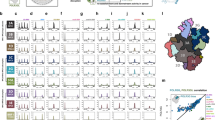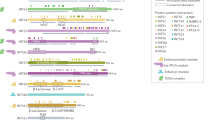Abstract
PTEN is a tumor-suppressor gene that has been shown to be under the regulatory control of a PTEN pseudogene expressed noncoding RNA, PTENpg1. Here, we characterize a previously unidentified PTENpg1-encoded antisense RNA (asRNA), which regulates PTEN transcription and PTEN mRNA stability. We find two PTENpg1 asRNA isoforms, α and β. The α isoform functions in trans, localizes to the PTEN promoter and epigenetically modulates PTEN transcription by the recruitment of DNA methyltransferase 3a and Enhancer of Zeste. In contrast, the β isoform interacts with PTENpg1 through an RNA-RNA pairing interaction, which affects PTEN protein output through changes of PTENpg1 stability and microRNA sponge activity. Disruption of this asRNA-regulated network induces cell-cycle arrest and sensitizes cells to doxorubicin, which suggests a biological function for the respective PTENpg1 expressed asRNAs.
This is a preview of subscription content, access via your institution
Access options
Subscribe to this journal
Receive 12 print issues and online access
$189.00 per year
only $15.75 per issue
Buy this article
- Purchase on Springer Link
- Instant access to full article PDF
Prices may be subject to local taxes which are calculated during checkout






Similar content being viewed by others
References
Xing, M. Genetic alterations in the phosphatidylinositol-3 kinase/Akt pathway in thyroid cancer. Thyroid 20, 697–706 (2010).
Alimonti, A. et al. Subtle variations in Pten dose determine cancer susceptibility. Nat. Genet. 42, 454–458 (2010).
Poliseno, L. et al. A coding-independent function of gene and pseudogene mRNAs regulates tumour biology. Nature 465, 1033–1038 (2010).
Khachane, A.N. & Harrison, P.M. Assessing the genomic evidence for conserved transcribed pseudogenes under selection. BMC Genomics 10, 435 (2009).
Pei, B. et al. The GENCODE pseudogene resource. Genome Biol. 13, R51 (2012).
Suo, G. et al. Oct4 pseudogenes are transcribed in cancers. Biochem. Biophys. Res. Commun. 337, 1047–1051 (2005).
Hawkins, P.G. & Morris, K.V. Transcriptional regulation of Oct4 by a long non-coding RNA antisense to Oct4-pseudogene 5. Transcription 1, 165–175 (2010).
Lin, H., Shabbir, A., Molnar, M. & Lee, T. Stem cell regulatory function mediated by expression of a novel mouse Oct4 pseudogene. Biochem. Biophys. Res. Commun. 355, 111–116 (2007).
Piehler, A.P. et al. The human ABC transporter pseudogene family: evidence for transcription and gene-pseudogene interference. BMC Genomics 9, 165 (2008).
Morris, K.V., Santoso, S., Turner, A.M., Pastori, C. & Hawkins, P.G. Bidirectional transcription directs both transcriptional gene activation and suppression in human cells. PLoS Genet. 4, e1000258 (2008).
Yu, W. et al. Epigenetic silencing of tumour suppressor gene p15 by its antisense RNA. Nature 451, 202–206 (2008).
Yap, K.L. et al. Molecular interplay of the noncoding RNA ANRIL and methylated histone H3 lysine 27 by polycomb CBX7 in transcriptional silencing of INK4a. Mol. Cell 38, 662–674 (2010).
Weinberg, M.S. et al. The antisense strand of small interfering RNAs directs histone methylation and transcriptional gene silencing in human cells. RNA 12, 256–262 (2006).
Turner, A.M., Ackley, A.M., Matrone, M.A. & Morris, K.V. Characterization of an HIV-targeted transcriptional gene-silencing RNA in primary cells. Hum. Gene Ther. 23, 473–483 (2012).
Jeffery, L. & Nakielny, S. Components of the DNA methylation system of chromatin control are RNA-binding proteins. J. Biol. Chem. 279, 49479–49487 (2004).
Viré, E. et al. The Polycomb group protein EZH2 directly controls DNA methylation. Nature 439, 871–874 (2006).
Malecová, B. & Morris, K.V. Transcriptional gene silencing through epigenetic changes mediated by non-coding RNAs. Curr. Opin. Mol. Ther. 12, 214–222 (2010).
Kuzmichev, A., Nishioka, K., Erdjument-Bromage, H., Tempst, P. & Reinberg, D. Histone methyltransferase activity associated with a human multiprotein complex containing the Enhancer of Zeste protein. Genes Dev. 16, 2893–2905 (2002).
Cao, R. et al. Role of histone H3 lysine 27 methylation in Polycomb-group silencing. Science 298, 1039–1043 (2002).
Han, J., Kim, D. & Morris, K.V. Promoter-associated RNA is required for RNA-directed transcriptional gene silencing in human cells. Proc. Natl. Acad. Sci. USA 104, 12422–12427 (2007).
Bernstein, P., Peltz, S.W. & Ross, J. The poly(A)-poly(A)-binding protein complex is a major determinant of mRNA stability in vitro. Mol. Cell Biol. 9, 659–670 (1989).
Fuke, H. & Ohno, M. Role of poly (A) tail as an identity element for mRNA nuclear export. Nucleic Acids Res. 36, 1037–1049 (2008).
Brodsky, A.S. & Silver, P.A. Pre-mRNA processing factors are required for nuclear export. RNA 6, 1737–1749 (2000).
Mahmoudi, S. et al. Wrap53, a natural p53 antisense transcript required for p53 induction upon DNA damage. Mol. Cell 33, 462–471 (2009).
Chang, F. et al. Involvement of PI3K/Akt pathway in cell cycle progression, apoptosis, and neoplastic transformation: a target for cancer chemotherapy. Leukemia 17, 590–603 (2003).
Weng, L., Brown, J. & Eng, C. PTEN induces apoptosis and cell cycle arrest through phosphoinositol-3-kinase/Akt-dependent and -independent pathways. Hum. Mol. Genet. 10, 237–242 (2001).
Ebert, M.S., Neilson, J.R. & Sharp, P.A. MicroRNA sponges: competitive inhibitors of small RNAs in mammalian cells. Nat. Methods 4, 721–726 (2007).
Langmead, B., Trapnell, C., Pop, M. & Salzberg, S.L. Ultrafast and memory-efficient alignment of short DNA sequences to the human genome. Genome Biol. 10, R25 (2009).
Robinson, J.T. et al. Integrative genomics viewer. Nat. Biotechnol. 29, 24–26 (2011).
Amarzguioui, M., Rossi, J.J. & Kim, D. Approaches for chemically synthesized siRNA and vector-mediated RNAi. FEBS Lett. 579, 5974–5981 (2005).
Polson, A., Durrett, E. & Reisman, D. A bidirectional promoter reporter vector for the analysis of the p53/WDR79 dual regulatory element. Plasmid 66, 169–179 (2011).
Han, J., Kim, D. & Morris, K.V. Promoter-associated RNA is required for RNA-directed transcriptional gene silencing in human cells. Proc. Natl. Acad. Sci. USA 104, 12422–12427 (2007).
Weinberg, M.S. et al. The antisense strand of small interfering RNAs directs histone methylation and transcriptional gene silencing in human cells. RNA 12, 256–262 (2006).
Turner, A.M., De La Cruz, J. & Morris, K.V. Mobilization-competent lentiviral vector-mediated sustained transcriptional modulation of HIV-1 expression. Mol. Ther. 17, 360–368 (2009).
Turner, A.M., Ackley, A.M., Matrone, M.A. & Morris, K.V. Characterization of an HIV-targeted transcriptional gene-silencing RNA in primary cells. Hum. Gene Ther. 23, 473–483 (2012).
Acknowledgements
The project was supported by: the US National Institute of Allergy and Infectious Disease grants R56 AI096861-01 and P01 AI099783-01 to K.V.M. and National Cancer Institute grant R01 CA151574 and US National Institutes of Health grant R01 CA153124 to P.K. Vogt (supporting K.V.M.); the Swedish Childhood Cancer Foundation, The Swedish Cancer Society, Radiumhemmets Forskningsfonder, the Karolinska Institutet PhD support programme and Vetenskapsrådet to D.G.; and the Erik and Edith Fernstrom Foundation for medical research to P.J. and the Swedish Childhood Cancer Foundation.
Author information
Authors and Affiliations
Contributions
P.J. and K.V.M. designed, performed and supervised the experiments. A.A. and L.V. performed experiments. M.C. provided helpful discussions. W.-O.L. supervised ChIP-sequencing analysis. D.G. supervised the experiments. P.J., D.G. and K.V.M. wrote the paper.
Corresponding authors
Ethics declarations
Competing interests
The authors declare no competing financial interests.
Supplementary information
Supplementary Text and Figures
Supplementary Figures 1–6 and Supplementary Tables 1–2 (PDF 6184 kb)
Rights and permissions
About this article
Cite this article
Johnsson, P., Ackley, A., Vidarsdottir, L. et al. A pseudogene long-noncoding-RNA network regulates PTEN transcription and translation in human cells. Nat Struct Mol Biol 20, 440–446 (2013). https://doi.org/10.1038/nsmb.2516
Received:
Accepted:
Published:
Issue Date:
DOI: https://doi.org/10.1038/nsmb.2516
This article is cited by
-
Progress of HOTAIR-microRNA in hepatocellular carcinoma
Hereditary Cancer in Clinical Practice (2022)
-
Signaling pathways and targeted therapies in lung squamous cell carcinoma: mechanisms and clinical trials
Signal Transduction and Targeted Therapy (2022)
-
Long-read cDNA sequencing identifies functional pseudogenes in the human transcriptome
Genome Biology (2021)
-
Unveiling the long non-coding RNA profile of porcine reproductive and respiratory syndrome virus-infected porcine alveolar macrophages
BMC Genomics (2021)
-
The lnc-CTSLP8 upregulates CTSL1 as a competitive endogenous RNA and promotes ovarian cancer metastasis
Journal of Experimental & Clinical Cancer Research (2021)



